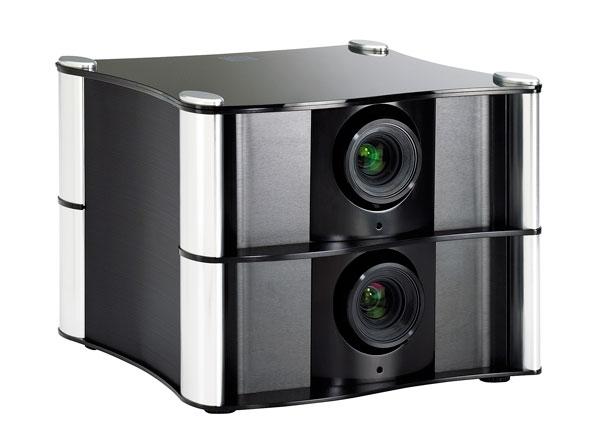Runco D-73d 3D DLP Projector, Part 4

As I've mentioned previously, for most of our viewing, we used a Stewart 5D polarization-preserving screen (16:9, 87 inches wide, 2.5 gain), which I profile here. It was the latest version of the 5D material that can be microperfed and mounted in a retractable mechanism, though in this case, it was not microperfed, and it was mounted in a fixed CineCurve frame.
The source devices included a Panasonic DMP-BDT350 3D Blu-ray player and a Popcorn Hour A-110 media server loaded with custom 3D content. Movies were played at 1080p/24, and the D-73d displayed them at 24fps—according to Bob Williams, chief product architect and recent guest on my Home Theater Geeks podcast, this is exactly how digital-cinema projectors display movies, with no double or triple flashing as with film projectors.
But before we got to real-world content, I was curious to see how well the 3Dimension processor handled the deinterlacing tests on the Spears & Munsil High-Definition Benchmark Blu-ray test disc, which was stored on the A-110 at 1080i. The processor passed the 3:2 and 2:2 pulldown tests, which are interlaced from material captured on film and progressive video, respectively. Many displays pass the 3:2 test, but few deinterlace 2:2 well.
The motion-adaptive tests consist of images captured at 1080i and 480i, and the D-73d's performance with them was borderline. In the shots of the sailing ship, there were some mild jaggies in the rigging and yellow trim on the hull, as there were in the cables of the Brooklyn Bridge shots and the edges of the safety glass in the hockey shots.
![]()
Of course, no 3D-display evaluation would be complete without watching Avatar. The 3D looked superb—very smooth and engaging. The colors were excellent, but they looked somewhat oversaturated due to the fact that we were using the projector's Native color gamut, which I hadn't gotten used to yet.
Skin tones in the live-action scenes looked surprisingly natural thanks to a feature called Smart Color, which automatically adjusts skin tones so people don't look sunburned, and it lowers the brightness of other colors so they don't glow. As we switched between the Native and Rec.709 gamuts, the skin tones didn't change, but the green in the computer displays sure did—the Rec.709 green looked positively washed out—and the reds were much more red in Native, less orange than Rec.709.

I saw much the same thing in Imax: Space Station 3D—red shirts were much less orange in Native while skin tones remained natural. There's lots of stuff in the far foreground on this disc, which tends to break up and stutter in motion, but that's not the projector's fault. The shadow detail in a dark compartment was very good, and the overall detail was sharp and crisp.

The 3D effect on Grand Canyon Adventure was very natural except for the title sequence, when text in water droplets comes flying out of the screen. Red suitcases looked much redder in the Native gamut while skin tones looked fine. I was beginning to prefer Native with Smart Color over Rec.709!

I brought along one of my favorite 3D Blu-ray titles, Goldberg Variations: Acoustica from AIX Records, on which a live musical performance was shot in 3D. The diagonal guitar and bass strings looked solid with no jaggies, and the 3D effect was very natural. As before, I found myself preferring the look of the Native gamut with Smart Color.

Switching to the A-110 server, we watched a bit of Imax: Into the Deep 3D recorded from 3net on DirecTV, which broadcasts in the side-by-side format with half the normal horizontal resolution for each eye. It looked pretty sharp to me—I didn't really notice the drop in horizontal resolution, especially in shots with little motion, though fast-moving fish did look more blurred than I think they would have with full resolution for both eyes.

Also stored on the A-110 was Runco's CEDIA demo from last year, which includes trailers for Alice in Wonderland and Monsters vs. Aliens and a clip of Tiger Woods playing golf, all in the side-by-side format. The difference between the Native and Rec.709 gamuts was most striking on the Tiger Woods clip—the green grass looked totally washed out and yellowish in Rec.709, while it was vibrant but not overbearing in Native, and skin tones remained entirely natural. I also noted that the shadow detail in some dark scenes from Alice looked very good.

In addition to 3D, we looked at some 2D material using one of the D-73d's projection engines. Of course, this cut the light output in half, but taking off the polarized glasses compensated quite nicely, resulting in a gorgeous picture. The overall detail in The Dark Knight on Blu-ray was superb, as was the shadow detail in dark scenes. Again, I ended up preferring the Native gamut with Smart Color over Rec.709. And all the same comments apply equally well to Baraka on Blu-ray. In both cases, I found nothing to complain about watching 2D images on the Stewart 5D screen.

Finally, we moved the Stewart screen to the side and spent a bit of time with a very unusual screen from a Korean company called Mocom, the Solstice Cinematix 1. This polarization-preserving screen is made of solid fiberglass with a gain of 10! (It's spec'd with a gain of 18, but that's only for a true point source; Runco has measured an effective gain of 10 with the D-73d.) How can it possibly avoid hot-spotting? By using compound curvature—that is, being curved horizontally and vertically. In essence, it's part of a huge sphere. Placing the projector at a distance equal to half the sphere's radius, light from the lens is reflected back to the audience in parallel rays.
Also, sitting close to the screen reduces hot-spotting even more. In fact, Williams recommends a viewing distance equal to the screen width, which is mighty close, but it's also important for optimizing the 3D effect.

The screen measured 12 feet wide with a 2.35 aspect ratio, so a pair of stacked anamorphic lenses on a motorized sled slid into place. We watched trailers for Disney's A Christmas Carol and Nightmare Before Christmas in 3D, both of which looked quite good with excellent color and detail. Walking around the screen, I was impressed at the lack of hot-spotting, though the brightness dropped dramatically once I got past the edge of the screen.

Unfortunately, the car that would take me to the airport arrived before we could do any more viewing on that big screen. Still, it was wonderful to spend an entire day playing with the D-73d, which is an exceptional projector—as it should be for $49,995, not counting the CineWide with AutoScope motorized anamorphic-lens system, which adds another $22,400 to the price tag. (Also available is a fixed CineWide system with no motorized sled for somewhat less.)
Sure, that's a lot of dough, but the 3D experience provided by this projector is unsurpassed by anything I've seen for the home and even in most commercial cinemas, though the D-73d can't adequately fill a large commercial screen. And its 2D performance is superb as well. The benefits of LED illumination and a dual-projector system with passive polarization are many, and the drawbacks are few, so if you're into 3D and you have a big budget, I can't think of a better way to go.
- Log in or register to post comments




































































